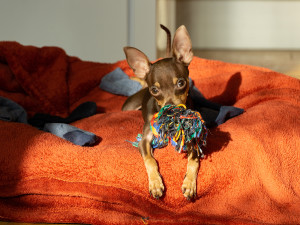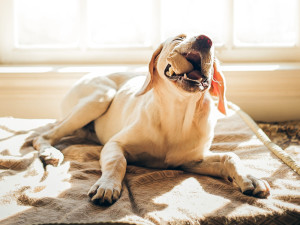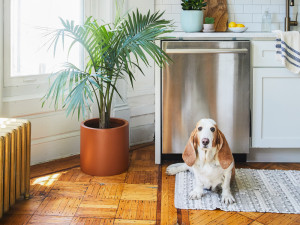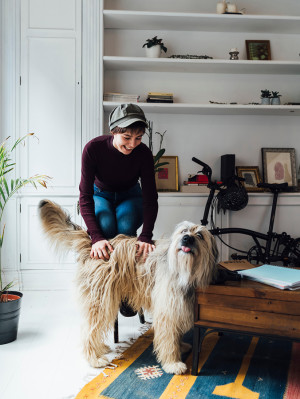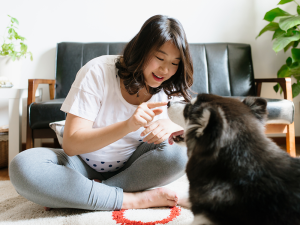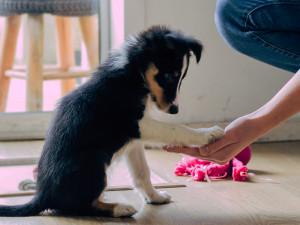How to Puppy Proof Your Home
Is your home a danger zone for a new dog? Follow these pro tips.
The best part of bringing a puppy home is the puppy, obviously. But next best is all the guilt-free shopping you get to do. Faux fur beds, hand-thrown ceramic bowls, and a closet of knitted sweaters worthy of Coveteur. Before you get ahead of yourself, your new dog den needs to be as safe as it is stylish. Puppies in particular can get into all sorts of trouble — it’s kind of their thing. Protect your shag rug and the dog who will undeniably try to stomach it, and read on for eight ways to puppy-proof your digs.
Think like a dog
Dogs explore the world with their mouths, which is simultaneously fascinating and gross. Puppies are notorious chewers, especially when they’re teething. But even adult dogs may feel so inclined to gnaw on whatever looks palatable at the moment or when they’re anxious. Don’t hold your breath waiting for your dog to outgrow this bad habit; nip it in the bud before they ingest something dangerous.
“Your goal when dog-proofing is to clear the area of anything they may feel compelled to chew, not only because it’s destructive, but also because swallowing items can be very harmful,” says certified dog trainer Lisa Plymale. “At the same time, you can provide them with appropriate chew toys so they can fulfill their natural tendency to chew. I recommend that people get several toys and rotate through them. That will help keep your dog from getting bored and finding something else to chew instead.”
Move valuables to the top shelf
Those Air Jordans you just scored on The RealReal? Probably not a good idea to leave them on the floor. Before you bring your new dog home, do a sweep of any areas where they’ll be spending time and remove prized possessions within their reach. While you’re at it, move anything fragile or breakable until you get a better sense of how prone your pup is to destructive behavior (or general clumsiness). Not-so-fun fact: dogs like chewing leather shoes because they resemble rawhide which, as it happens, is just as dangerous a choking hazard and can cause gastrointestinal obstruction. Yikes!
Hide cords and cables
It goes without saying that chewing electrical cords is a recipe for disaster. At the least, your laptop won’t charge (and those chargers are not cheap!). Or, your dog could burn their mouth or start a fire. Hide snarls of cords behind furniture or use cord covers (ideally made from heavy gauge medical-grade tubing) to deter your dog from sinking their teeth into them. And don’t forget blind cords, which small dogs can get tangled up in.
Secure (or block) certain pieces of furniture
You know how it ends when you hastily climb a bookcase to reach something on the top shelf. Lofty furniture can topple if your dog attempts your cat’s acrobatics, so anchor it to the wall with brackets. Depending on their size and dexterity, securing your flat screen and dresser might be wise as well. Dr. Susannah Teran warns that pieces of furniture can pose a higher risk for certain breeds: “Dogs with longer backs, such as Dachshunds and Corgis, shouldn’t be allowed to jump on and off couches, beds, or chairs because of the risk of spinal injury. You may be able to train your dog to use doggie stairs, or block access altogether.”
Latch cabinets and enclose trash cans
If there’s one thing dogs are not — when it comes to food, that is — it’s wasteful. An unlidded trash is practically begging for a dumpster dive. Unless you want to come home to a TikTok-worthy guilty dog vignette, secure your garbage with a lid or hide it inside a cabinet. Speaking of, some dogs are impressively adept at opening cabinet doors. Thumbs, apparently, are overrated. Safety latches will stand between your pup and potentially dangerous items such as medications or toxic cleaning products.
And don’t forget about the garage. “I always warn pet parents about antifreeze,” says Dr. Teran. “While most people assume that antifreeze isn’t good for dogs, they may not realize that dogs are drawn to it. The ingredient in antifreeze that is extremely toxic to dogs also has a sweet taste that dogs may find tempting, so watch out for any drips or puddles that accumulate on the floor of your garage.”
ID your plants
You’d be surprised how many common houseplants are toxic to dogs, including but not nearly limited to the sago palm, pothos, and lilies. Though not all dogs will eat your greens, it’s not worth the risk. Check the ASPCA’s Toxic Plant Listopens in new tab and toss anything noxious. You’ve got something more important to keep alive now.
Crates and gates will give you peace of mind
It’s impossible to completely puppy-proof every inch of your home. That’s where crates and gates can make keeping your dog safe more manageable. “As long as you’ve taken steps to acclimate your dog to a crate, it can be a great way to give them a safe space when you’re not there to supervise,” says Plymale. “Baby gates are another option, but keep in mind they don’t provide total control of the environment. Your dog would still have access to anything in the room they deem chew-worthy such as couch cushions, table legs, or even the wall.” Yes, she said the wall.
Of course, the ultimate goal is to get to a place where your dog is less likely to get into trouble in the first place. Plymale has a pro tip for that too: “When you’re home and able to keep an eye on your dog, use those opportunities to work on training. Teach them boundaries and the rules of the household. As your dog becomes more trustworthy, you can increase their freedom to move about the house when you’re not there.”


